Raphael Tapestry: Blinding of the Elymas
Artist: Flemish manufacturing - workshop of Pieter van Aelst
Date: 1515 - 1521
Classification: Tapestry
Dimensions: 579 x 501 cm
Materials: Wool, Silk, Gold, Silver
Adopted By: The Michigan Chapter
Total Cost: $ 797,100
Description
The Tapestry of The Blinding of Elymas features a man enthroned at center, watching on as an altercation takes place in the foreground: two men stand before the king, one pointing at the other, as a group of onlookers gathers in the background. It is a mirror-image of one of the seven large Raffaello Sanzio cartoons for tapestries belonging to the British Royal Collection, but it has been on loan to the Victoria and Albert Museum in London since 1865.
Designed by the High Renaissance painter Raphael in 1515–16, these cartoons depict scenes from the Gospels and Acts of the Apostles. They are the only surviving members of a set of ten designs commissioned by Pope Leo X intended to decorate the lateral lower walls of the Sistine Chapel which are still hung below Michelangelo's famous ceiling on special occasions.
Elymas was a Jewish magician who appears in the New Testament in Chapter 13 of the Acts of the Apostles. Acts of the Apostlescalls him a magus,which the King James Bible translates as "sorcerer." He is represented opposite Paul of Tarsus and Barnabas in the city of Paphos on Cyprus, when the Roman Proconsul Sergius Paulus wishes to hear Paul and Barnabas speak about Jesus. Because of his opposition, Paul states that God made him temporarily unable to see as a cloud of darkness immediately begins to block his sight. Subsequently, Sergius Paulus converts to Christianity.
State of Preservation
The tapestry is composed of two distinct sections: the upper portion is original, having survived to the Sack of Rome of 1527, and the lower part is made of a grass extract base, a reproduction of the missing original piece. The original lower portion, destroyed by a fire during the Sack of Rome, was later duplicated on a faux tapestry fabric during its restoration by Silvio Grossi in 1930-1931. He decided to reproduce the missing part of the tapestry on a grass-based support so that a complete read of the artwork would be possible. A brown gimp was put into the split between the tapestry and the painted fabric to maintain the integrity of the work.
The original portion of the tapestry presents several visible missing and worn threads. Previous restorations, for both the alteration of the color and the type of restoration, prevent an accurate reading of the artwork.
The tapestry is lined with bands. The lower portion is in fair condition, but this area also exhibits worn fibers. The item appears as a unified work as it is composed by two distinct parts: tapestry and grass canvas. The artwork must be treated separately, in two parts, to accomodate the material dichotomy.
Restoration Procedures
- Photographic and graphic documentation
- Removal of the cover
- Documentation of previous interventions
- Removal of incoherent deposits with microaspirator.
- Study of the fibers to determine their conservation status as well as to identify the original colors of the fiber threads and the grass-based portion
- Removal of previous restorations
- Separation between the upper and lower parts
- Cleaning and washing preparation: application and repair of synthetic tulle on the back and heat-sealed mesh on the front to avoid further deterioration of the fabric
- Immersion cleaning in deionised water and non-ionic surface cleaner
- Dyeing of spun yarns and textiles
- Conservative intervention and restoration using alternate stitching and decorations of matching colour support
- Cleaning of the fabric
- Dyeing of filaments and fabrics
- Reintegration of the tears
- Reunion of the two portions, replacing the gimp affixed by Grossi in the original position.
- Application of Velcro for suspension
Detail
Adopted By:
The Michigan ChapterInventory N°: 43873
Artist: Flemish manufacturing - workshop of Pieter van Aelst
Date: 1515 - 1521
Provenience: Brussels
Dimensions: 579 x 501 cm
Materials: Wool, Silk, Gold, Silver
Department:
Byzantine - Medieval ArtCurators:
Dr. Alessandra Rodolfomuseum:
PinacotecaLaboratories:
Tapestry and TextilesWishbook year: 2014
Total Cost
$ 797,100
Restoration Report Update
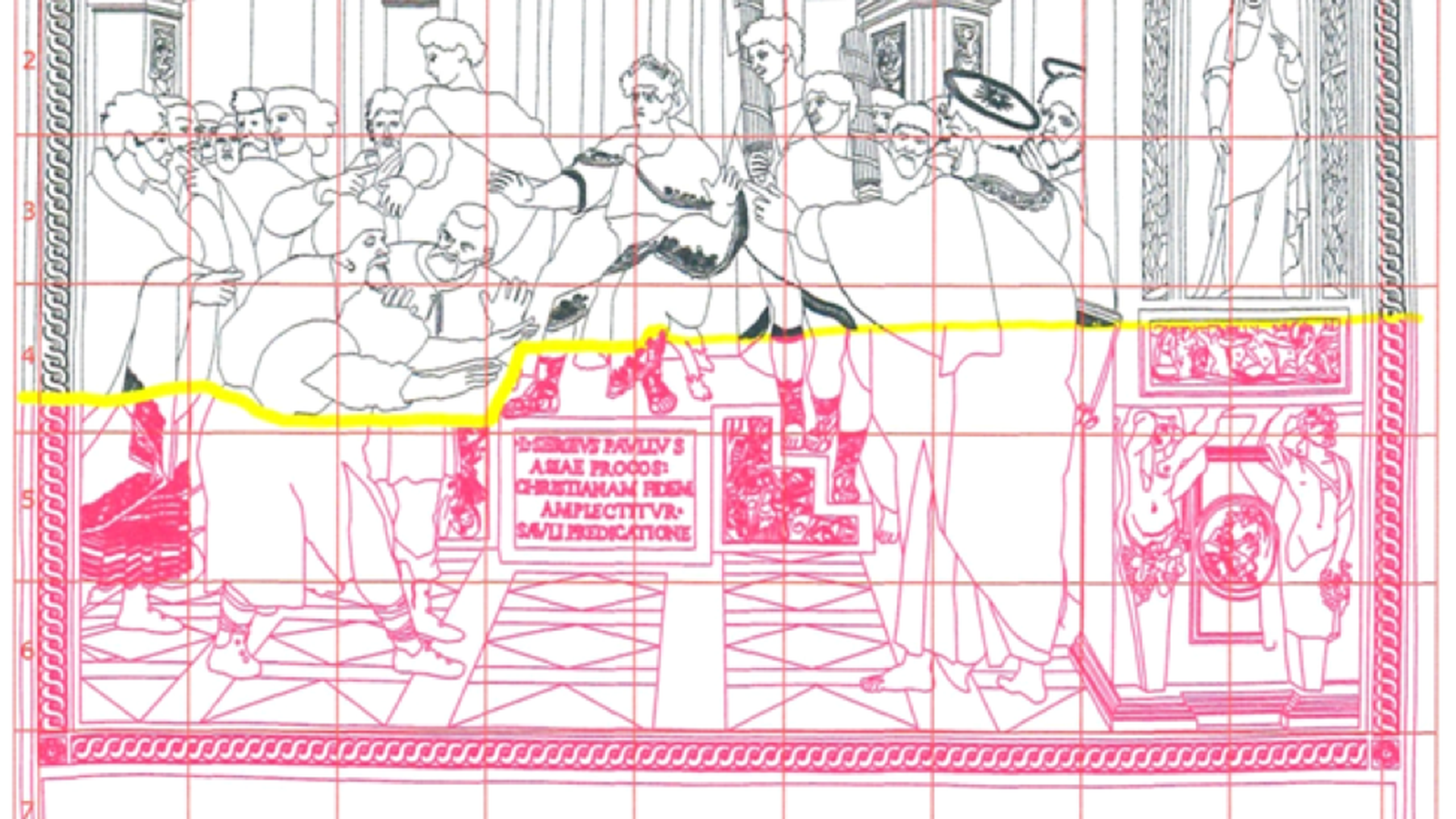
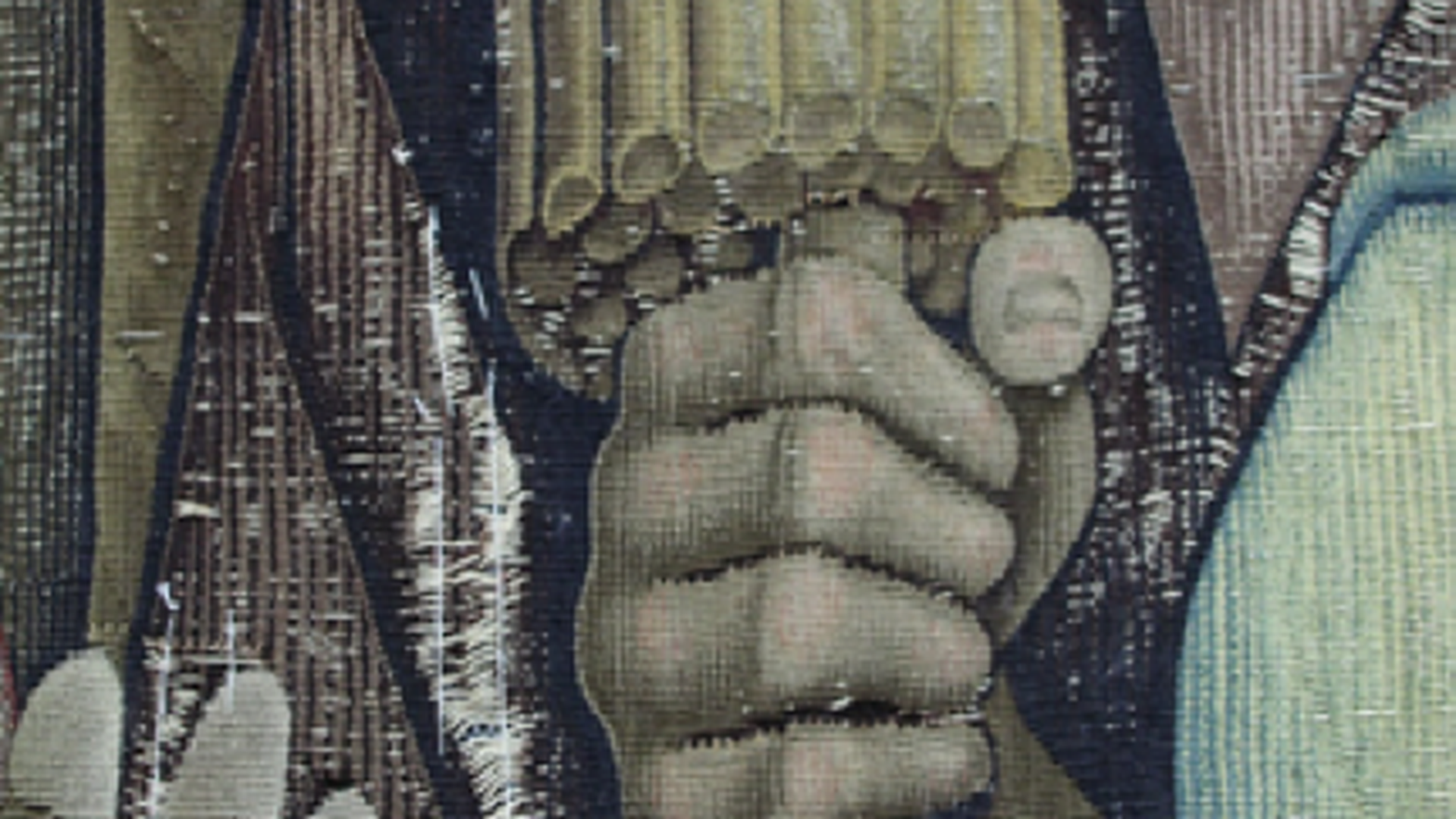
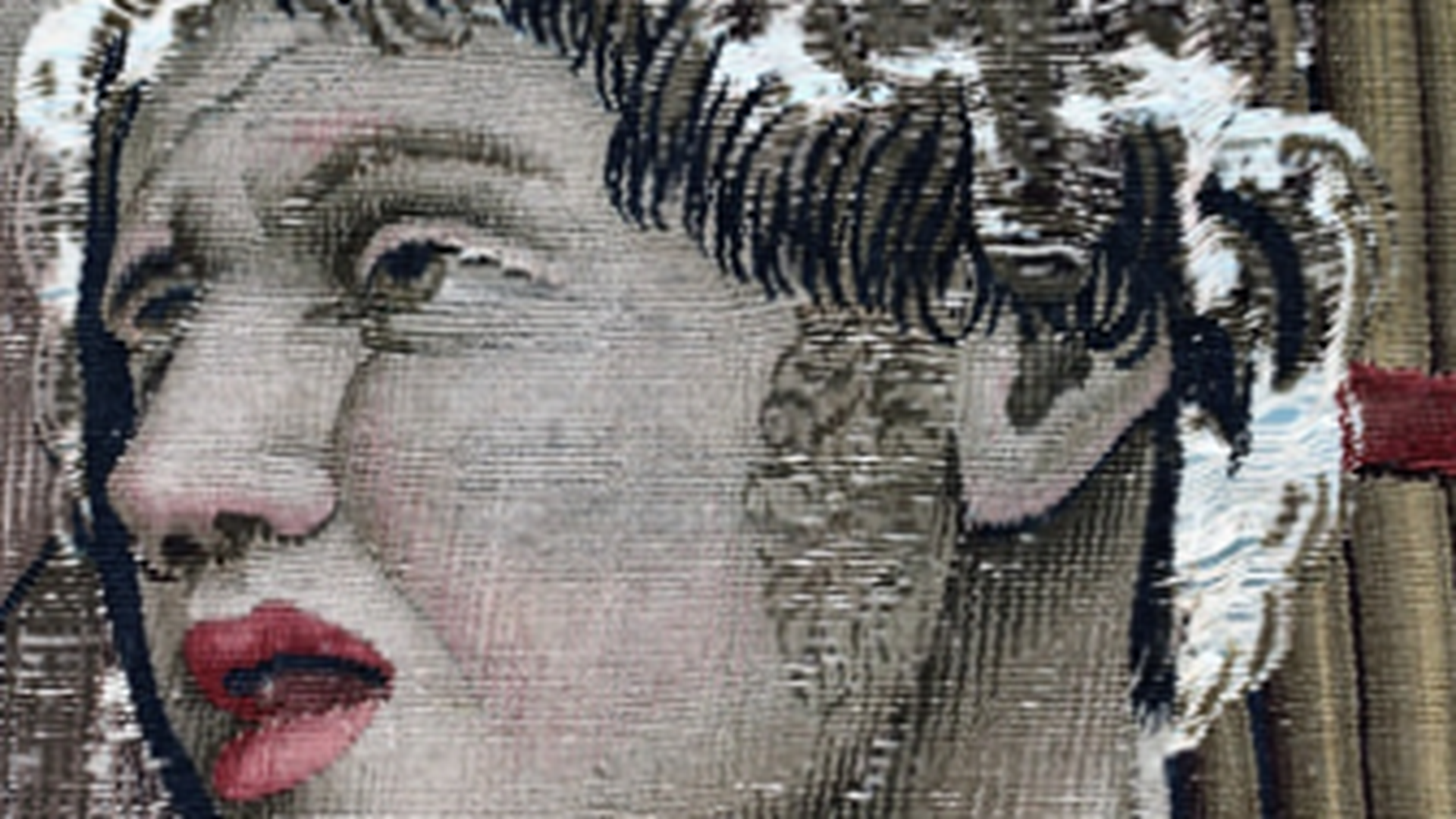
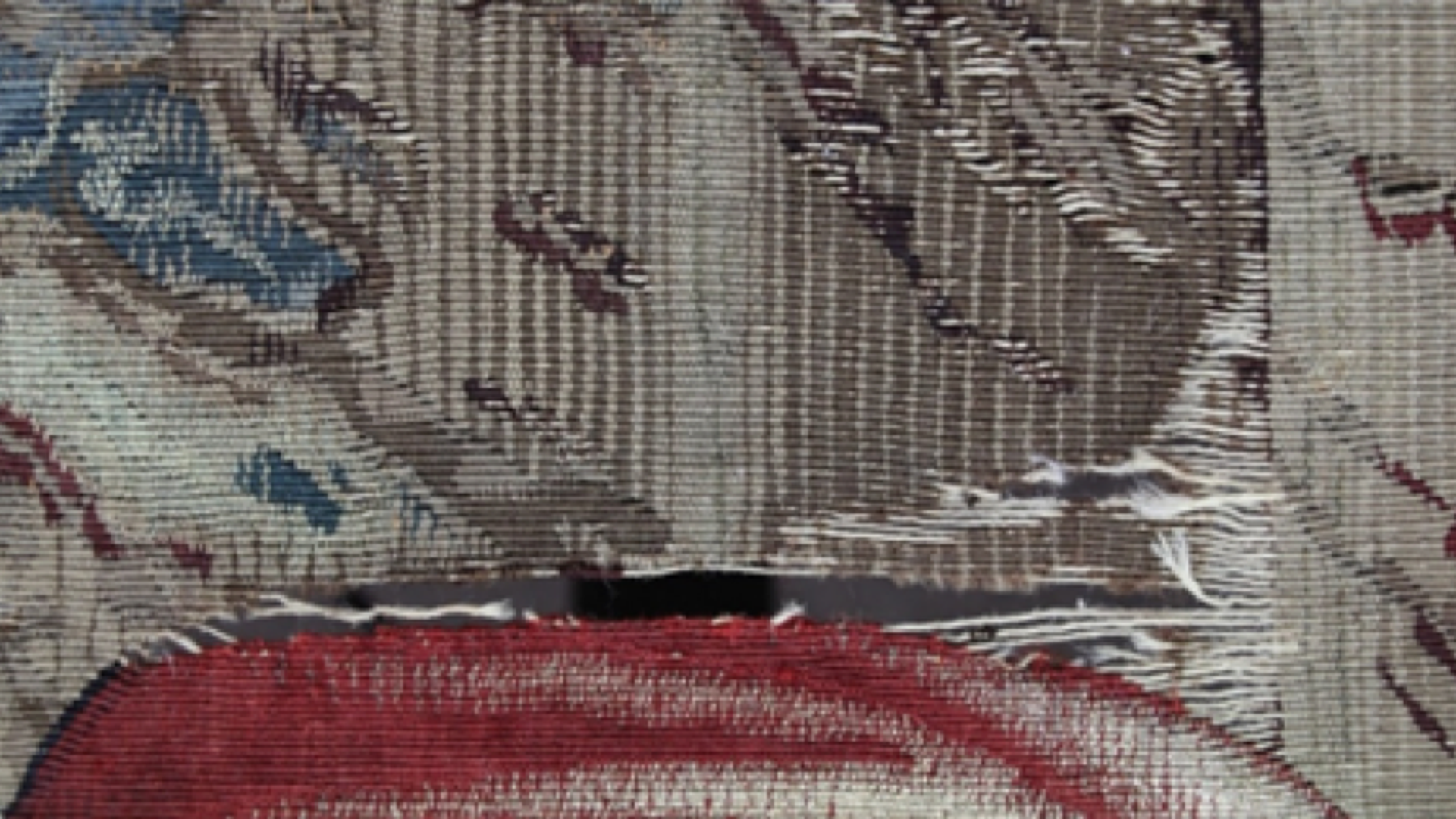
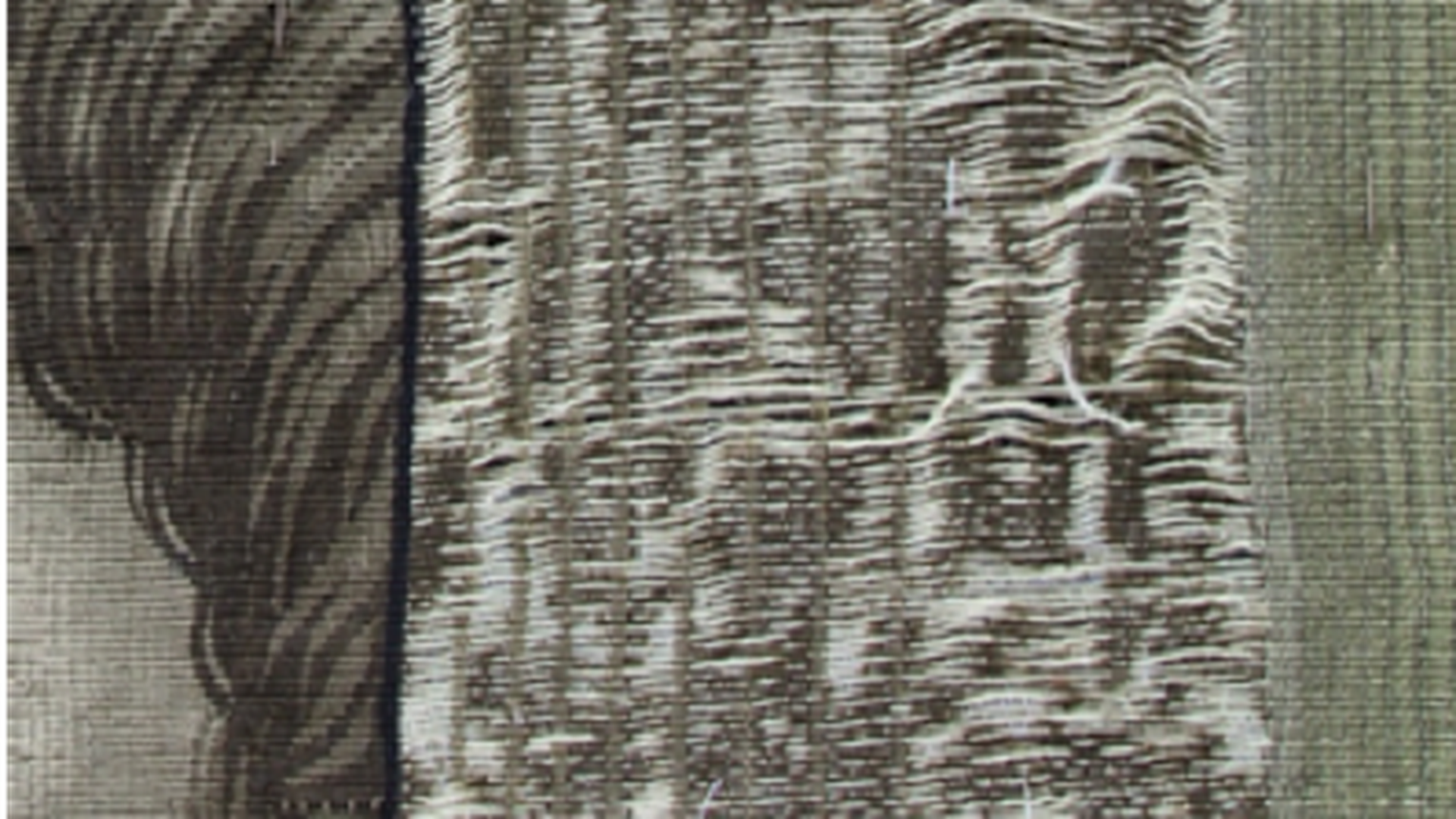
The restoration work on the "Blinding of Elymas" tapestry in recent months has continued in central zone A-L/2-3. The dyeing of yarns necessary for the alternating stitch consolidation work was carried out.
In zone G 2 the total lack (warps and weft) was consolidated with a neutral conservative restoration, i.e. by inserting a specially dyed support and stitching the perimeter of the gap area. The free warps in the surrounding areas, on the other hand, were stopped with alternating stitches.
During the week of February 17-22 2020, the tapestries of the entire series of Raphael's Acts of the Apostles were exhibited in the Sistine Chapel to celebrate the 500th anniversary of the death of the Urbinate artist. The tapestry depicting the "Blinding of Elymas" as part of the prestigious series was exhibited together with the other tapestries.
At the end of the exhibition, the tapestry was repositioned on the restoration frame in order to proceed with the consolidation.

Raphael Tapestry: Blinding of the Elymas
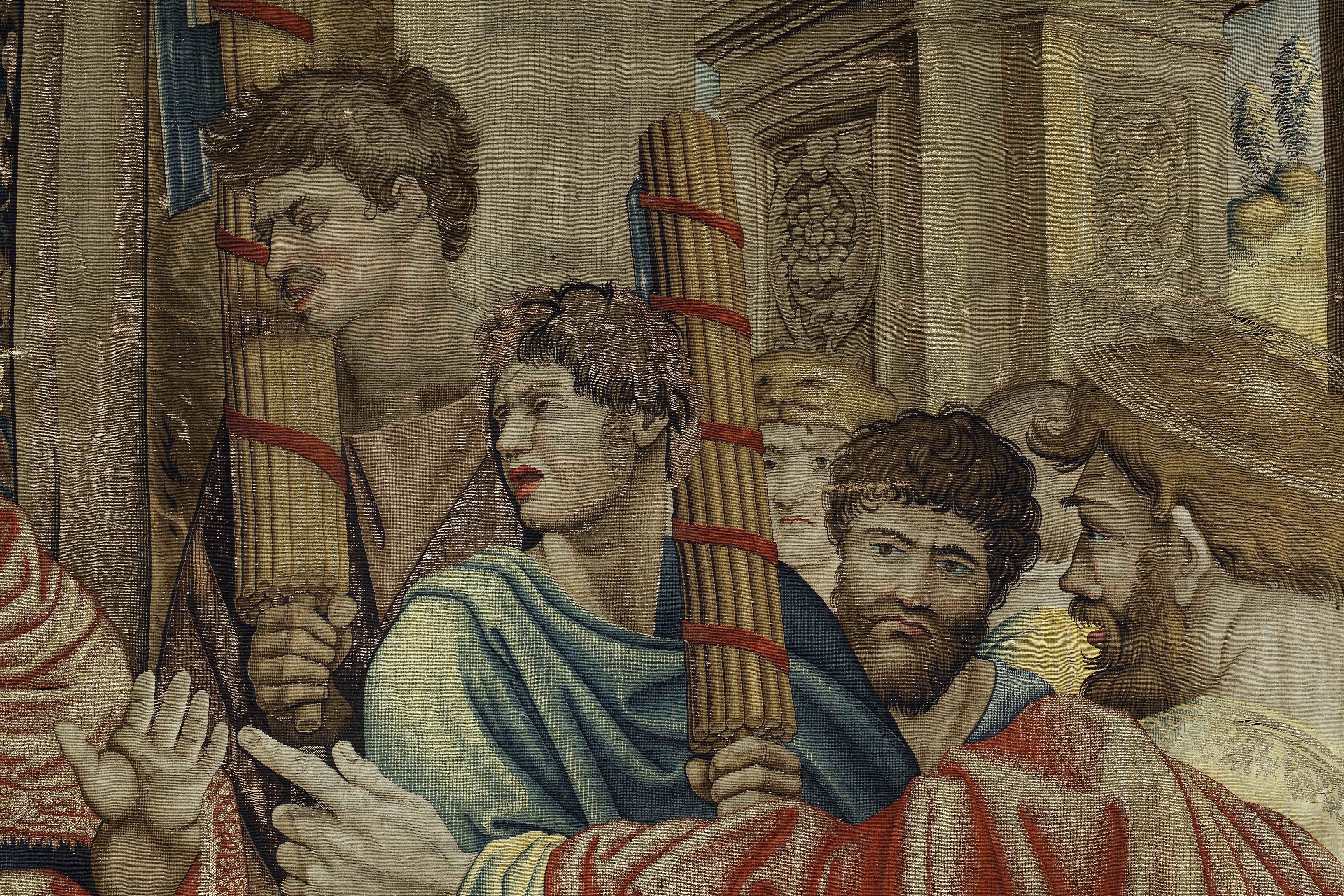
Details
Adopted by: The Michigan Chapter
Inventory: 43873
Artist: Flemish manufacturing - workshop of Pieter van Aelst
Date: 1515 - 1521
Provenience: Brussels
Classification: Tapestry
Materials: Wool, Silk, Gold, Silver
Dimensions: 579 x 501 cm
Museum: Pinacoteca
Department: Byzantine - Medieval Art
Laboratory: Tapestry and Textiles
Wishbook year: 2014
Description
The Tapestry of The Blinding of Elymas features a man enthroned at center, watching on as an altercation takes place in the foreground: two men stand before the king, one pointing at the other, as a group of onlookers gathers in the background. It is a mirror-image of one of the seven large Raffaello Sanzio cartoons for tapestries belonging to the British Royal Collection, but it has been on loan to the Victoria and Albert Museum in London since 1865.
Designed by the High Renaissance painter Raphael in 1515–16, these cartoons depict scenes from the Gospels and Acts of the Apostles. They are the only surviving members of a set of ten designs commissioned by Pope Leo X intended to decorate the lateral lower walls of the Sistine Chapel which are still hung below Michelangelo's famous ceiling on special occasions.
Elymas was a Jewish magician who appears in the New Testament in Chapter 13 of the Acts of the Apostles. Acts of the Apostlescalls him a magus,which the King James Bible translates as "sorcerer." He is represented opposite Paul of Tarsus and Barnabas in the city of Paphos on Cyprus, when the Roman Proconsul Sergius Paulus wishes to hear Paul and Barnabas speak about Jesus. Because of his opposition, Paul states that God made him temporarily unable to see as a cloud of darkness immediately begins to block his sight. Subsequently, Sergius Paulus converts to Christianity.
State of Preservation
The tapestry is composed of two distinct sections: the upper portion is original, having survived to the Sack of Rome of 1527, and the lower part is made of a grass extract base, a reproduction of the missing original piece. The original lower portion, destroyed by a fire during the Sack of Rome, was later duplicated on a faux tapestry fabric during its restoration by Silvio Grossi in 1930-1931. He decided to reproduce the missing part of the tapestry on a grass-based support so that a complete read of the artwork would be possible. A brown gimp was put into the split between the tapestry and the painted fabric to maintain the integrity of the work.
The original portion of the tapestry presents several visible missing and worn threads. Previous restorations, for both the alteration of the color and the type of restoration, prevent an accurate reading of the artwork.
The tapestry is lined with bands. The lower portion is in fair condition, but this area also exhibits worn fibers. The item appears as a unified work as it is composed by two distinct parts: tapestry and grass canvas. The artwork must be treated separately, in two parts, to accomodate the material dichotomy.
Restoration Procedures
- Photographic and graphic documentation
- Removal of the cover
- Documentation of previous interventions
- Removal of incoherent deposits with microaspirator.
- Study of the fibers to determine their conservation status as well as to identify the original colors of the fiber threads and the grass-based portion
- Removal of previous restorations
- Separation between the upper and lower parts
- Cleaning and washing preparation: application and repair of synthetic tulle on the back and heat-sealed mesh on the front to avoid further deterioration of the fabric
- Immersion cleaning in deionised water and non-ionic surface cleaner
- Dyeing of spun yarns and textiles
- Conservative intervention and restoration using alternate stitching and decorations of matching colour support
- Cleaning of the fabric
- Dyeing of filaments and fabrics
- Reintegration of the tears
- Reunion of the two portions, replacing the gimp affixed by Grossi in the original position.
- Application of Velcro for suspension
Media
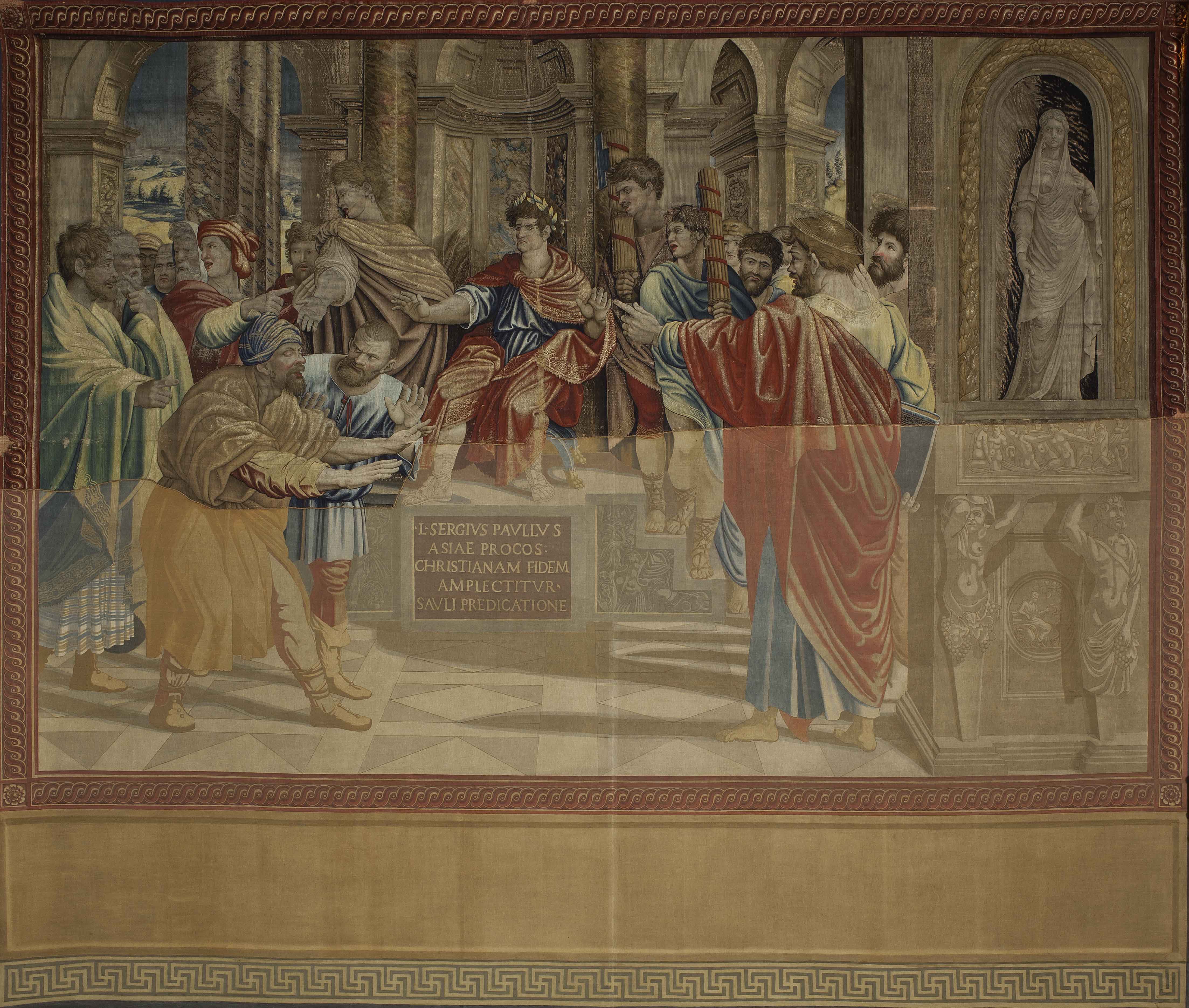
Blinding of the Elymas
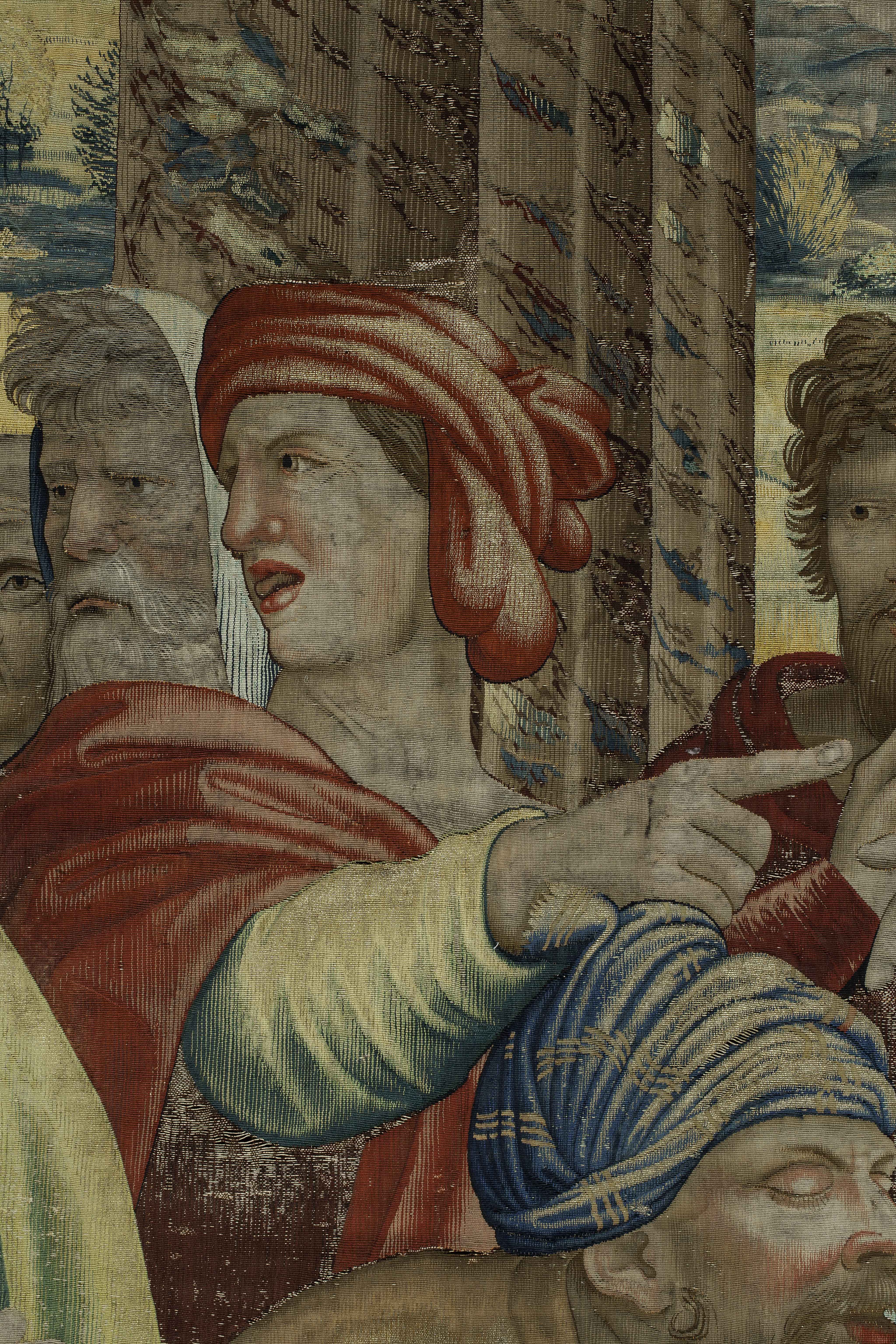
Blinding of the Elymas - Detail
Restorations Update: Restoration Report Update
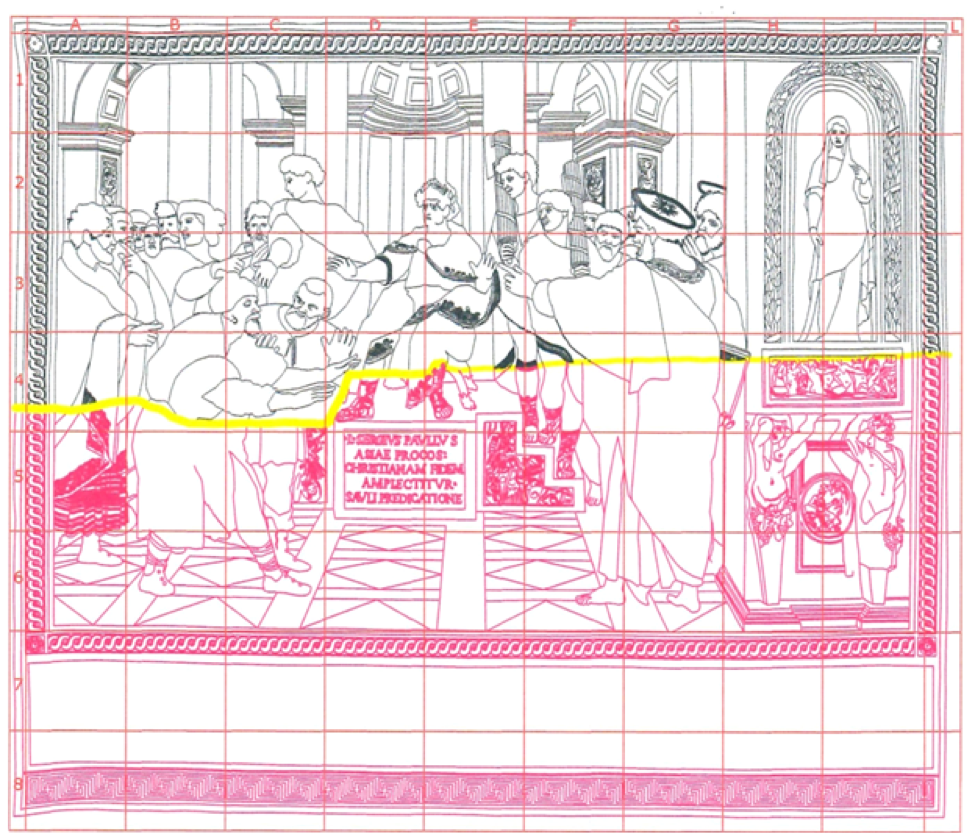
The restoration work on the "Blinding of Elymas" tapestry in recent months has continued in central zone A-L/2-3. The dyeing of yarns necessary for the alternating stitch consolidation work was carried out.
In zone G 2 the total lack (warps and weft) was consolidated with a neutral conservative restoration, i.e. by inserting a specially dyed support and stitching the perimeter of the gap area. The free warps in the surrounding areas, on the other hand, were stopped with alternating stitches.
During the week of February 17-22 2020, the tapestries of the entire series of Raphael's Acts of the Apostles were exhibited in the Sistine Chapel to celebrate the 500th anniversary of the death of the Urbinate artist. The tapestry depicting the "Blinding of Elymas" as part of the prestigious series was exhibited together with the other tapestries.
At the end of the exhibition, the tapestry was repositioned on the restoration frame in order to proceed with the consolidation.
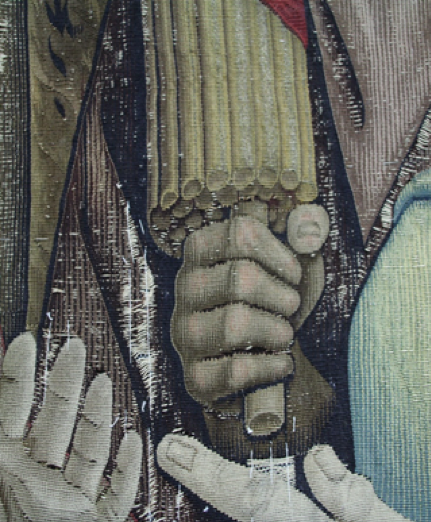

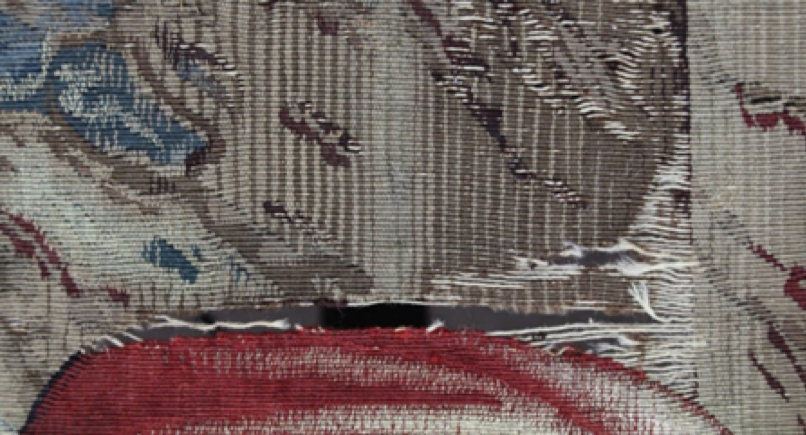
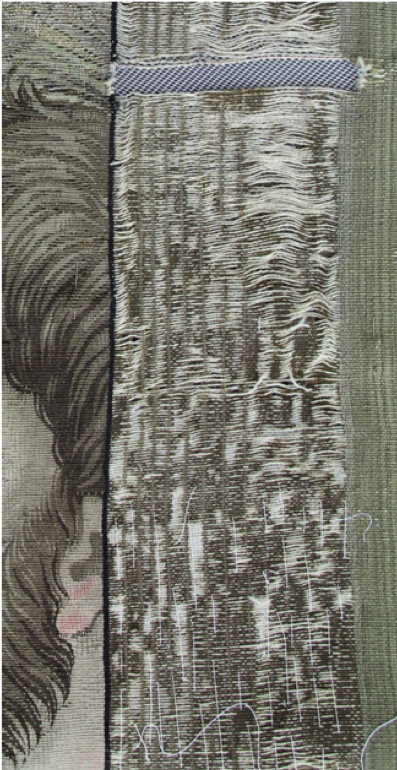
Exhibition History
Five hundred years after the death of Raphael, his tapestries return to the Sistine Chapel
Sistine Chapel, Vatican Museums
from Feb 17, 2020 to Jul 23, 2020

© 2025 Patrons of the Arts
in the Vatican Museums
Vatican Museums V-00120,
Vatican City State (Europe)
+39 0669864499
